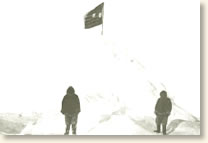|

Peary at the North Pole
April 6, 1909
|
At the turn of the century, explorers regarded the North Pole as the last prize in the Northern Hemisphere. The quest for the Pole turned into an international race with teams from Britain, Norway and America vying for the distinction of reaching it first. Robert Peary, a Commander in the U.S. Navy, made his first attempt to reach the Pole in 1893. Two more expeditions followed (1898-1902 and 1905-1906). Both fell short of the mark, but the efforts propelled Peary to the distinction of America's foremost Arctic explorer.
The expedition of 1908-09 was to be his last try. On September 5, 1909 Peary
emerged from the Arctic wilderness and announced to the world that he had reached
the North Pole on April 6. A simultaneous announcement by Frederick A. Cook
(also an American) that he had achieved the Pole a year earlier (April 21,
1908) diminished Peary's triumph. Cook's claim was soon rejected, he did not
have sufficient proof and his whereabouts on the Arctic ice became suspect.
He soon fled the scene. In 1922, Cook landed in Leavenworth Penitentiary for
mail fraud.
Peary's claim also ran into trouble. Like Cook, his evidence was thin and he
proved uncooperative in revealing his logbooks and diaries that may have supported
his assertion. An Act of Congress in 1911 recognized Peary's claim, but this
was a political accolade rather than an endorsement by the scientific community
that remained divided in its judgement. Peary died in 1920. The dispute over
his claim of being the first to reach the North Pole continues today.
References: Herbert, Wally, The Noose of Laurels, Robert E. Peary and the Race to the North Pole (1989); Rawlins, Dennis, Peary at the North Pole, Fact or Fiction? (1973)
|






